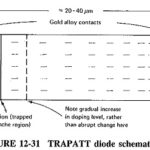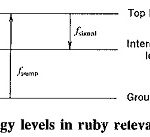Semiconductor Microwave Devices Articles:
Trapatt Diode Construction and Working: The Trapatt Diode Construction and Working is derived from and closely related to the IMPATT diode. Indeed, as pointed out near the beginning of this section, at first it was merely a different, “anomalous,” method of … (Read More)
Stripline and Microstrip Transmission Line: Stripline and Microstrip Transmission Line are physically related to transmission lines but are covered here because they are microwave circuits used in conjunction with semiconductor microwave devices. As illustrated of Stripline and Microstrip Transmission Line shown … (Read More)
Surface Acoustic Waves Devices(SAW): Surface Acoustic Waves Devices may be propagated on the surfaces of solid piezoelectric materials, at frequencies in the VHF and UHF regions. Devices employing SAW principles were first discussed in the late 1960s, then moved out of … (Read More)
High Frequency Limitations: As stated, transistors suffer from High Frequency Limitations. These are of a twofold nature. On the one hand, there are the same difficulties as those encountered with tubes, On the other hand, there is some difficulty in specifying … (Read More)
Microwave Transistors: Silicon bipolar transistors were first on the microwave scene, followed by GaAs field-effect transistors. Indeed, FETs now have noticeably lower noise figures, and in the C band and above they yield noticeably higher powers. A description of Microwave Transistors … (Read More)
Varactor Diode Operation and Characteristics: Varactor Diode Operation and Characteristics were first used in the early 1950s as simple voltage-variable capacitance and later for frequency modulation of oscillators. They thus represent a very mature semiconductor microwave art. As materials and construction … (Read More)
Frequency Multiplier Circuit: A typical Frequency Multiplier Circuit chain is shown in Figure 12-11, The first stage is a transistor crystal oscillator, operating in the VHF region, and this is the only circuit in the chain to which dc power is … (Read More)
Parametric Amplifier: The parametric amplifier uses a device whose reactance is varied in such a manner that amplification results. It is low-noise because no resistance need be involved in the amplifying process. A varactor diode is now always used as the … (Read More)
Parametric Amplifier Types: The basic Parametric Amplifier Types have already been discussed in detail, but several others also exist. They differ from one another in the variable reactance used, the bandwidth required and the output frequency (signal or idler). Various other … (Read More)
Tunnel Diode Equivalent Circuit: The Tunnel Diode Equivalent Circuit, when biased in the negative-resistance region, is shown in Figure 12-18. At all except the highest frequencies, the series resistance and inductance can be ignored. The resulting diode equivalent circuit is thus … (Read More)
Negative Resistance Amplifier: The classical application of the tunnel diode was in microwave oscillators, especially after it was realized that the secret of stable oscillations lay in loosely coupling the diode to its tuned circuit. Other semiconductor devices have subsequently appeared, … (Read More)
Tunnel Diode Applications: In all its Tunnel Diode Applications, the tunnel diode should be loosely coupled to its tuned circuit. With lumped components, this is done by means of a capacitive divider, with the diode connected to a tapping point, while … (Read More)
Gunn Effect: In 1963, Gunn discovered the transferred electron effect which now bears his name. This Gunn Effect is instrumental in the generation of microwave oscillations in bulk semiconductor materials. The effect was found by Gunn to be exhibited by gallium … (Read More)
Gunn Diode Working Principle: A practical Gunn Diode Working Principle consists of a slice like the one shown in Figure 12-24, sometimes with a buffer layer between the active layer and the substrate, mounted in any of a number of packages, … (Read More)
Impatt Diode Working: IMPATT Diode Working is a combination of delay involved in generating avalanche current multiplication, together with delay due to transit time through a drift space, provides the necessary 180° phase difference between applied voltage and the resulting current … (Read More)
Pin Diode Construction: The Pin Diode Construction consists of a narrow layer of p-type semiconductor separated from an equally narrow layer of n-type material by a somewhat thicker region of intrinsic material. The intrinsic layer is a lightly doped n-type semiconductor. … (Read More)
Schottky Barrier Diode: Schottky junctions have been shown and described throughout this chapter, in conjunction with various devices that use them in their construction in Figure 12-4. Accordingly it will be realized that the Schottky Barrier Diode is an extension of … (Read More)
Ruby Maser: As was know ferrites of certain materials have atomic systems that can be made to resonate magnetically at frequencies dependent on the atomic structure of the material and the strength of the applied magnetic field. When such a resonance … (Read More)
Cryogenically Cooled Amplifiers: The term solid-state is used deliberately here; it does not mean “semiconductor.” In terms of the somewhat older maser parlance, it means the opposite of gaseous, i.e., ruby. The cross section of a Cryogenically Cooled Amplifiers is shown … (Read More)
Pulsed Ruby Laser: The Pulsed Ruby Laser is similar to the ruby cavity maser, to some extent, in that stimulation is applied to raise the chromium atoms to a higher energy level to secure a population inversion once again. However, this … (Read More)
Continuous Wave Gas Laser: The first Continuous Wave Gas Laser, in 1961, was a gas laser using a mixture of helium and neon gases. These are still used, and a simplified He-Ne laser is shown in Figure 12-40. It operates in a … (Read More)
Semiconductor Lasers: Semiconductor Lasers was discovered in 1962 that a gallium arsenide diode, such as the one shown in Figure 12-41, is capable of producing laser action. This occurs when the diode is forward-biased, so that effective dc pumping is needed … (Read More)
Types of Optoelectronic Devices: Although light-emitting diodes and photodiodes are not quantum-mechanical devices in the Types of Optoelectronic Devices, they are semiconductor devices closely associated with lasers. It is most convenient to cover them here. Light Emitting Diodes (LEDs): The construction of an … (Read More)



















